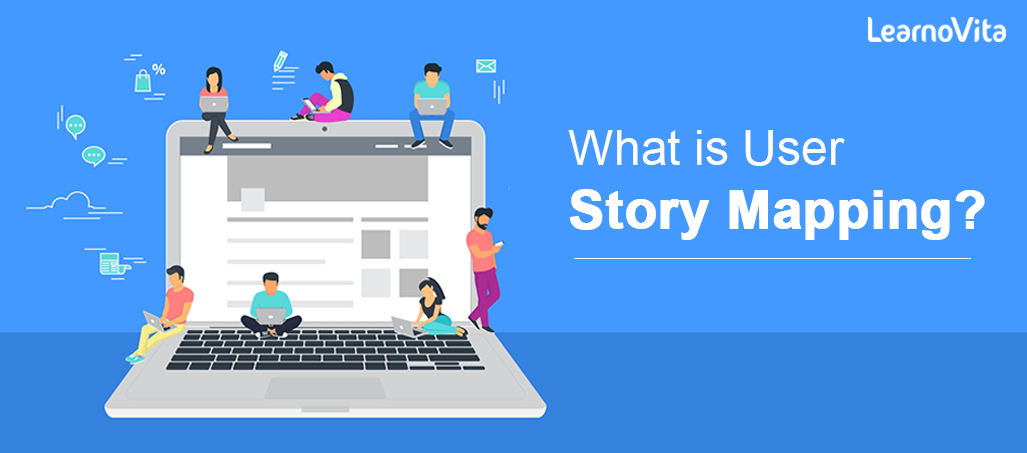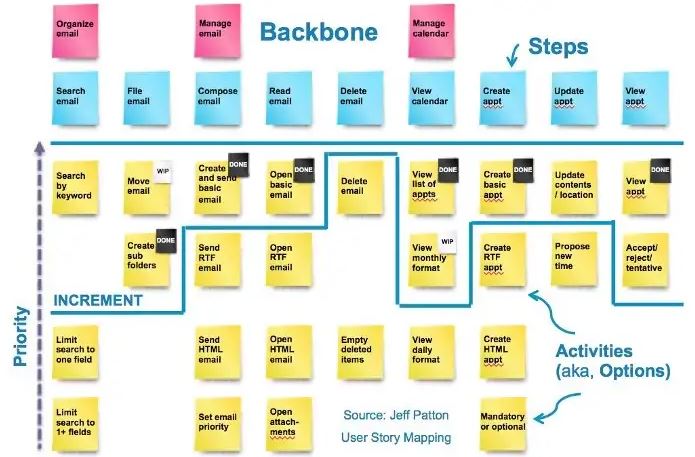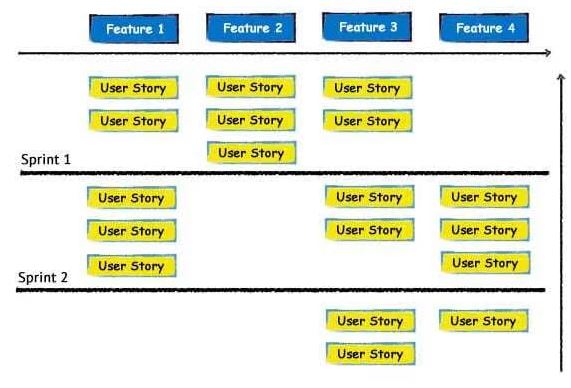
How to install Jenkins on Ubuntu? : A Complete Guide
Last updated on 30th Jan 2023, Artciles, Blog
- In this article you will learn:
- 1.What is a user story mapping?
- 2.User -Story Mapping Defined.
- 3.Why It’s Called User-Story Mapping.
- 4.What are some benefits of user story mapping?
- 5.Who should participate in user story mapping?
- 6.How does user story mapping work?
- 7.Conclusion.
What is a user story mapping?
User story maps are be simple, lightweight representations of a product development journey in Agile project. This method was famous by Jeff Patton who first wrote about it in book User Story Mapping, where outlined how this technique could be used to help keep a focus on user needs without getting a tangled up in never-ending product feature requirements.These story maps—which are changeable and keep evolving throughout a journey—enable the team to have a meaningful conversations about user needs through a development process, never losing sight of big picture.
User -Story Mapping Defined:
User story mapping can be explained as an exercise during which product managers and development teams list out a work that will create the most value to be end users, maximising customer delight.During this exercise, teams create a dynamic outline of ways in which the customer is expected to use a product. They try to understand which steps offer most value and prioritise stories accordingly. The user story format is amazingly simple, concise a sentence which clearly captures the requirements.
Why It’s Called a User-Story Mapping:
In user-story map all the activities are captured as a short phrases that represent actual user actions. The first half of user-story format therefore, talks about what user wants to do with product. Next, the story is elaborated to include a key benefits as the second half of the conversation. So, this mapping method is called a user-story mapping because it is cantered on user and his or her needs.
When and How to Create User Story Map:
The user story map is created as one of first exercises in a product development process. It is not rigid document, and evolves as the journey unfolds, in keeping with a spirit of Agile. Subsequently, user story mapping can be carried out whenever a team needs more clarity on how to improve on a first version, how to manage the backlog or when branching out in the new direction with requirements for a product extensions. These are processes involved in creating User Story Map:

1. Start with big picture:
Start by an identifying the big picture. What are the broad user applications that are product must support? Draft these big stories on a cards and arrange them in a order of priority for end user.
2. Break down bigger stories:
Each of these big user activities is now broken down into a smaller user tasks. Once again, keep a user in mind and prioritise these tasks from a user’s perspective. This is now a backbone of User Story Map.
3. Look for the gaps:
It helps to walk through a map with the customers or stakeholders. Is there anything have missed out? They will help to fill in a gaps.
4. Start prioritising:
Remember, at this stage it is still a high-level map and is highly likely to get a changed down line. Put a user tasks and subtasks within each activity into order of importance.
5. Select your first release:
From all tasks listed, choose a ones that will go into a first version, which will be MVP or Minimum Viable Product for an very first release.Once have the ball rolling, get started on a first release and then keep momentum alive by planning subsequent releases in a same way. As go along, will be re-ordering a user story map, aligning subsequent stories are horizontally to match a timeline, and creating order out of chaos.
What are some benefits of a user story mapping?
User story mapping is the systematic and highly efficient way of working out a task priorities. When done right, it provides a significant benefits that help teams build products that a customers will love.
Lays the focus on user:
Any product must be built with an end user in mind. A User story mapping shines a spotlight on the user’s needs and tells a story from the point of view of user. It maps out the user experience and helps to an emphasize the efforts that will lead to best outcomes, creating an outside-in approach rather than a traditional inside-out way of working.
Sets priorities :
By breaking down a bigger picture into smaller tasks, while always are keeping the vision in mind, teams can decide what is important and what needs to get a built first. A holistic visualisation of tasks helps to put a priorities in the right perspective. Teams will an organize releases around delivery of maximum value and push items of lower value to a bottom of the backlog.
Gives clarity on requirements:
When requirements are laid out in a form of strong user stories, teams get a clarity on what needs to be done. They can get the visual representation of how larger work items can get broken down into the smaller tasks and understand which are tasks that club together to make a one feature.
Delivers value quickly:
Work gets grouped together into an iterations, and releases are be planned around delivery of value. By working on more important tasks faster, teams can deliver a product increments more rapidly, get feedback early and maximise a customer value.
Mitigates risks early:
Risks and dependencies get an exposed early in a development journey, and developers can plan to mitigate these risks and iron out a potential obstacles to smooth progress of a work. Early planning can reduce the dependencies and streamline a tasks more effectively.
Builds team collaboration:
In the end, project progress will depend on how well a team works together. A User story mapping is a team building exercise where the team members get shared view of a customer experience and work together to map out tasks. Team collaboration is a built through meaningful conversations.

Who should participate in a user story mapping?
A User story mapping is one of most important exercises during a planning stage. It brings a cross functional teams into the better alignment and helps them work collaboratively toward building a best possible product in market. It is important that all the teams whose work will contribute toward a successful delivery should participate in a dialogue.Team members from an Engineering, UX/design, Product management, Sales, Customer support, Finance, Ops / IT, Legal and Marketing teams can take part in exercise and give valuable inputs.
How does user story mapping work?
Teams can use a planning software like a Lucid chart, or even simple physical resources like the chart or a section of wall with a sticky notes, to build the story map. Once they have decided on a medium to use, they can work on following steps:
1. explain the problem:
What is a problem that is solved by a product? This is a product goal, and it’s important to clearly define it at outset. Once the goal is explained , the work that is to done to achieve this goal can be mapped.
2. Understand a target audience:
Any user story exercise starts with the creating a persona as the end user. There could be several distinct categories of a users, and all must be discussed. Every target person will have a unique way of interacting with the product. Once a personas are understood, the user stories can be built from a perspective of each of these target users. This is the important aspect, as efforts are not wasted in a building features that may not be important to any of these end users.
What are some challenges of a user story mapping?
While user story mapping can yield a great results when done the right way, it comes with own set of challenges for a teams that are inadequately prepared.
No persona:
There might be an instances where there is a lack of clarity on who the end user is. In such cases, imagine persona who represents most possible end user, and work with this characterisation.
Lack of clarity on a end goal:
The product goal is a solution to problem that exists and is a reason for building the product. When there is a lack of clarity on a problem itself, then the team could end up building stories on a wrong goals. This will a waste time, money and effort and could be result in some unnecessary rework and lack of a motivation.
Not using a collaborative software :
Smaller teams who are co-located might find it makes sense to do their planning using a sticky notes on a wall, or markers on the whiteboard. What happens if someone cleans a whiteboard by mistake, or some of notes fall off and are swept away? All planning would have been in vain!
Repetitions and rework:
The stories in the user story map might need to be a rewritten in the form of product backlog, which involves a some rework. Instead, use a collaborative tools that map progress and automatically keep records of a work done. An added advantage of using a right tools is that distributed teams can also participate in a planning and tracking of a goals.
Conclusion:
Anyone who has created the user stories knows that this takes a time and effort, and the best results come with an experience. They allow teams to see bigger picture, keeping user at the core of all development progress. When done a right way, user story mapping promotes meaningful collaboration, enables the quicker feedback and faster deliveries, and results in a creating high-quality product features that are most suit customer needs.
Are you looking training with Right Jobs?
Contact Us- Hadoop Tutorial
- Hadoop Interview Questions and Answers
- How to Become a Hadoop Developer?
- Hadoop Architecture Tutorial
- What Are the Skills Needed to Learn Hadoop?
Related Articles
Popular Courses
- Hadoop Developer Training
11025 Learners - Apache Spark With Scala Training
12022 Learners - Apache Storm Training
11141 Learners
- What is Dimension Reduction? | Know the techniques
- Difference between Data Lake vs Data Warehouse: A Complete Guide For Beginners with Best Practices
- What is Dimension Reduction? | Know the techniques
- What does the Yield keyword do and How to use Yield in python ? [ OverView ]
- Agile Sprint Planning | Everything You Need to Know
